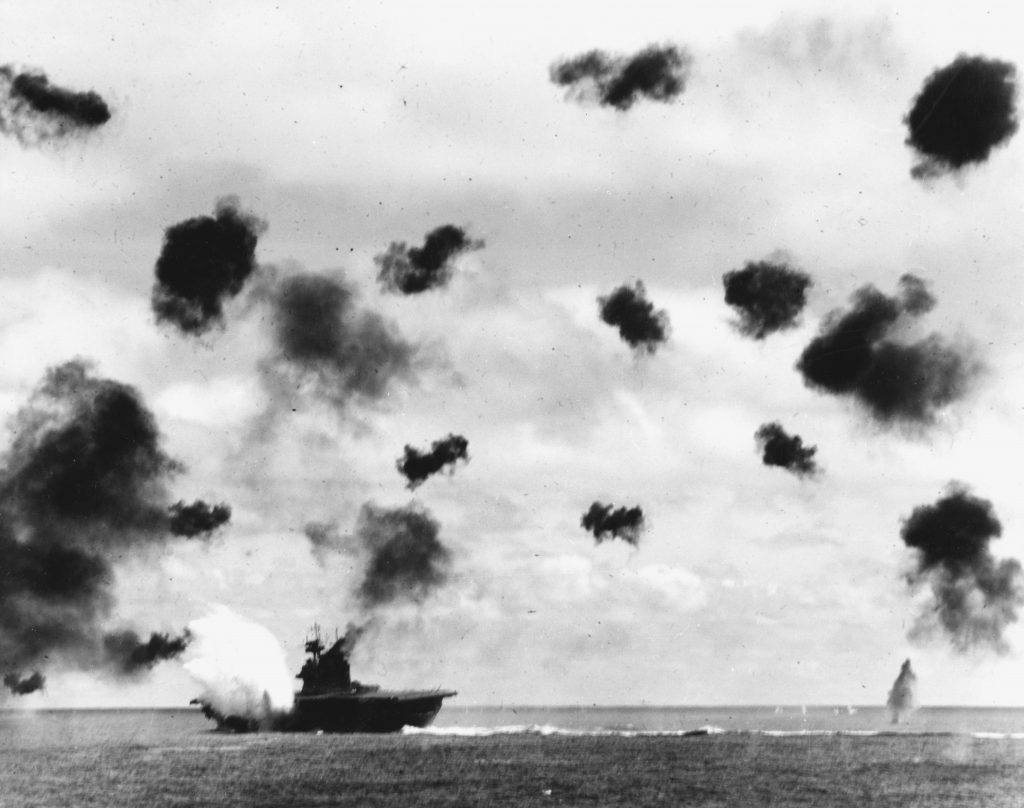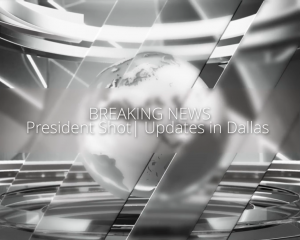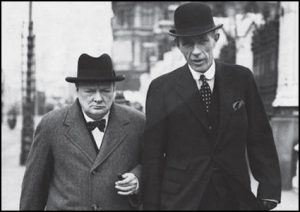Sunday, December 7, 1941 promised blue skies and warm temperatures at Pearl Harbor on the island of Oahu, Hawaii. Just prior to 8:00 a.m., the course of America’s history changed when the Japanese dropped bombs across the naval station from 350 planes. The unanticipated attack began on the U.S. Naval Yard and Battleship Row. More than 2,400 servicemen died and at least 1,200 were injured, four battleships sunk and four more took on extensive damage. Significant damage occurred to other parts of the Pacific fleet. The following day the United States of America declared war on Japan. For the next six months, the United States tried to gain the upper hand against Japan, but lost ground due to the lack of resources to carry out an attack against the Japanese Imperial Navy. The tide began to turn in May 1942.1
Admiral Chester W. Nimitz commanded the Pacific Fleet, replacing Admiral Husband Kimmel. Nimitz, a Texas native, said that “Pearl Harbor’s blame did not rest on any one person. Staff officers, who expected to be sacked by the new fleet commander, were stunned when he (Nimitz) explained he still considered them first rate. No one was more surprised or heartened by Nimitz’s words than Lt. Cmdr. Edwin Layton, Kimmel’s chief intelligence officer. Layton felt that he let Kimmel down and assumed he would be let go by his successor.”2
Nimitz leveraged the intelligence team led by Layton and one of Layton’s men, Lt. Cmdr. Joseph Rochefort, a cryptanalyst. Rochefort, like his superior, Layton, was fluent in Japanese. He led the combat intelligence unit at Pearl Harbor. Their unit succeeded in deciphering the Japanese code. On June 1, 1939, the Japanese had introduced what American cryptanalysts called JN-25. JN simply meant Japanese Navy and the 25 represented the number of revisions. JN-25 consisted of more than 33,000 words, phrases, and letters, and was the primary code the Japanese used to send military, as opposed to diplomatic, messages.3

The intelligence unit worked twenty-four hours a day, seven days a week for months trying to decipher the code. “To disguise the codes for frequently repeated words, such as battleship or attack, each five-digit code number in a message was altered by adding on a different five-digit number from the cipher table, which had 100,000 possible combinations. The sender then transmitted the message along with a numerical key, indicating the location of the cipher numbers in a table. To decipher the message, the officer receiving it used an identical cipher table and code-book to reverse the process.”4

The code-breaking consumed Rochefort and his men. They promised to avenge the deaths from Pearl Harbor. This single focus kept the men determined and concentrated on their goal. Rochefort and “his team of code breakers, mathematicians, linguists, and traffic analysts (specialists who used various techniques to determine the origin and destination of a message) were helped by the fact that the Japanese grew more confident and less careful in early 1942, as their stunning early triumphs instilled in them what they later called victory disease.”5 The team slowly made progress in breaking the codes. By April 1942, the combat intelligence unit was able to read about a third of the JN-25 code words and made educated guesses about Japanese naval plans.6
The Japanese were scheduled to change their special naval code on May 1. The task of distributing new codebooks was a challenge for the Japanese. They had to coordinate the change over a vast territory and transition the entire fleet to the new codebooks by a certain date. Due to the logistics, the distribution of the codebooks were delayed for one month. The decision to delay the distribution gave the U.S. Navy the break they needed. “The delay was a fatal error, for it allowed the Station Hypro cryptologists and analysts at Pearl Harbor to crack about 90% of it. In one of the biggest intelligence coups of the war, Rochefort and his team predicted the Japanese fleet was about to attack the Pacific island of Midway.” Part of the guess was based on the Japanese code for the target, indicated by the letters AF. But was “AF” actually Midway? “The analysts devised a means of finding out. Station Hypo directed the marines on the island to transmit a false message complaining that their freshwater condensers were causing trouble. When Midway complied, Japanese eavesdroppers intercepted the seemingly routine piece of information and promptly relayed it by code to higher headquarters and the Combined Fleet: AF was low on water. That message was heard in turn by the Americans, and it confirmed Midway was the target.”7

Admiral Nimitz then made plans based on an assumed attack at Midway. He had the forces needed to turn Midway into a stronghold. “Nimitz made a quick personal visit to the island, then dispatched orders to pack it with five thousand troops, a hundred planes—there was no room for more—and thickets of guns. If the Japanese tried to come ashore, it would cost them.”8
To understand how the Battle of Midway evolved, one must also understand the Japanese Imperial Navy and one of its highest ranking officers, Admiral Isoroku Yamamoto, commander in chief of the Combined Fleet of the Imperial Japanese Navy. The Japanese military leaders were embarrassed by the U.S. “Doolittle Raid” bombing of Tokyo in April 1942. The Japanese wanted revenge with a decisive attack that would end the war. A master strategist and knowledgeable of the U.S. Navy, Yamamoto chose Midway. Success at Midway would give Japan greater control of its perimeter and more command of the waters. Yamamoto also knew that the Americans would send any remaining aircraft carriers to protect their naval base at Midway. With the element of surprise on their side, the plan was for the large Japanese force to bomb the base at Midway and then attack and disable the U.S. fleet. As part of their protocol, Yamamoto’s naval officers met to rehearse the invasion. The war games concluded and the officers convinced themselves the attack plan was solid and that they could not fail.9

The Japanese launched an attack on the Aleutian Islands in Alaska in the early morning hours of June 3. The Japanese hoped to draw some U.S. naval forces in that direction; however, Yamamoto lacked some important information. He did not know that the Americans had cracked Japan’s naval code. The Americans saw the attack on the Aleutians for what it was—a diversion.10
As the battle approached, Admiral Nimitz initiated his plan that started with the confirmation of the “AF” code by Rochefort’s team. Admiral Nimitz ordered the Rear Admiral commanders of the USS Enterprise, the USS Hornet, and the USS Yorktown dispatched to the Midway Island. Admiral Yamamoto was unaware that the third carrier, the USS Yorktown, was ready for battle. Yamamoto’s intelligence was that the Yorktown was sunk after the Battle of the Coral Sea. The carrier, however, had been repaired in 48 hours of its arrival at Pearl Harbor. The third carrier was an advantage for Admiral Nimitz.11
June 4, 1942 at 4:30 a.m., the Japanese began their air attacks on the U.S. Navy at Midway Island. The U.S. aircrafts were damaged, but the airfields were not completely destroyed. At 7:15 a.m., the Japanese prepared for a second attack of the base when a Japanese scout plane saw the American fleet. When Vice Admiral Nagumo, commander of the Japanese Akagi, learned this unexpected news, he reversed his earlier decision of attacking Midway and instead ordered the planes to be rearmed with torpedoes instead of bombs. Rear Admiral Fletcher of USS Yorktown, in overall command of the American forces, ordered planes released from the USS Enterprise and USS Hornet at 7:00 a.m. The attack was not well coordinated. The losses between the two U.S. carriers were significant. Only six torpedo bombers returned, and only 14 of 82 airmen survived.12
Later in the morning, the U.S. Navy’s luck changed when other groups of dive bombers from the USS Enterprise and the USS Yorktown directly hit three Japanese carriers. Each of these Japanese carriers had bombs and torpedoes on their decks and the carriers burst into flames. This was the pivotal break that the U.S. Navy needed. The battle continued on for two more days. Admiral Yamamoto ordered his defeated fleet to return to base on the morning of June 5th. The Americans continued the fight and damaged more enemy destroyers and cruisers. The afternoon of June 6th, the Japanese submarine I-168 further damaged the USS Yorktown. The U.S. Navy attempted to keep the trusted carrier afloat for more than 48 hours. During the early morning hours of June 7th, the USS Yorktown rolled over and sank.13
There is much debate on the strategies that were deployed at Midway. When the strategies of the admirals are discussed, historians cite that the Japanese commanders were slow to react to the changing battle circumstances. Lessons learned stated that the Japanese were overconfident in their superior force and underestimated the determination of the U.S. Navy. The Japanese commanders were not encouraged to adjust to Yamamoto’s detailed plan during their training exercises and could not respond quickly with the surprised American attack. Admiral Nimitz expected more autonomy from his commanders. He emphasized the ultimate objectives of sinking the enemy’s aircraft carriers and used calculated risk to achieve that goal. This direction allowed the U.S. commanders to react to the unexpected during the battle. In the end, U.S. Pacific fleet lost 340 men, one aircraft carrier, one destroyer, and 145 aircraft. The Japanese lost more than 3,000 men, four aircraft carriers, one heavy cruiser, and 228 aircraft. Many of the Japanese killed were their best pilots and crews, a loss that could not be overcome.14
The American victory at Midway marked a turning point in the Pacific Theater. It was the first major defeat of the Japanese Navy in 350 years. It was the beginning of the end to Japan’s actions in the Pacific. Over the next three years, the U.S. forces slowly pushed the Japanese back to their mainland islands. The gains that Japan had fought for were lost.15 The Battle at Midway was successful due to the code breakers, the leadership of Admiral Nimitz, and the dedication of the servicemen of the United States Navy.
- Stephen G. Hyslop, Eyewitness to World War II: Unforgettable Stories From History’s Greatest Conflict, ed. Neil Kagan (Washington, DC: National Geographic Partners, 2018), 52. ↵
- Stephen G. Hyslop, Eyewitness to World War II: Unforgettable Stories From History’s Greatest Conflict, ed. Neil Kagan (Washington, DC: National Geographic Partners, 2018), 121. ↵
- Encyclopedia of Espionage, Intelligence, and Security Online, s.v. “World War II, United States Breaking of Japanese Naval Codes,” http://www.faqs.org (accessed February 4, 2020). ↵
- Stephen G. Hyslop, Eyewitness to World War II: Unforgettable Stories From History’s Greatest Conflict, ed. Neil Kagan (Washington, DC: National Geographic Partners, 2018), 124. ↵
- Stephen G. Hyslop, Eyewitness to World War II: Unforgettable Stories From History’s Greatest Conflict, ed. Neil Kagan (Washington, DC: National Geographic Partners, 2018), 123-124. ↵
- Stephen G. Hyslop, Eyewitness to World War II: Unforgettable Stories From History’s Greatest Conflict, ed. Neil Kagan (Washington, DC: National Geographic Partners, 2018), 125. ↵
- Donald A. Davis, Lightning Strike (New York: St. Martin Press, 2005), 99-100. ↵
- Donald A. Davis, Lightning Strike (New York: St. Martin Press, 2005), 100. ↵
- Barbara D. Krasner, “The Battle of Midway,” Cobblestone, May/June 2014, 26-31. ↵
- Barbara D. Krasner, “The Battle of Midway,” Cobblestone, May/June 2014, 26-31. ↵
- Barbara D. Krasner, “The Battle of Midway,” Cobblestone, May/June 2014, 26-31. ↵
- Barbara D. Krasner, “The Battle of Midway,” Cobblestone, May/June 2014, 26-31. ↵
- Barbara D. Krasner, “The Battle of Midway,” Cobblestone, May/June 2014, 26-31. ↵
- Barbara D. Krasner, “The Battle of Midway,” Cobblestone, May/June 2014, 26-31. ↵
- Barbara D. Krasner, “The Battle of Midway,” Cobblestone, May/June 2014, 26-31. ↵



40 comments
Rawan Hawsawi
The introduction employed by the author is captivation. At the introduction level, one is already well-furnished with the consequence of the US involvement in World War II in terms of actual figures. The introduction captures not only the imagination of the reader but also evokes patriotism and empathy for the United States since it is carefully detailed that Japan was the aggressor in the conflict
Nnamdi Onwuzurike
Personally, I enjoy learning about WWII, and this article is fantastic! I find it interesting to learn about decoding because it is a seemingly little yet crucial concept. Since no one could speak Navajo, the US was able to use code through that language, which contributed to their victory in the conflict. Without the decoders, the Battle of Midway would have been lost, and American history would have been altered irrevocably.
Iris Reyna
Good job on the article Samuel, it was informative and educational and was put together nicely. It did a good job of addressing who in my opinion had a major effect on the war, They put a lot of work to be able to break the codes that allowed government officials the ability to create a better plan. Government officials are recognized the most for World War II but I think that the code breakers had a significant part in the war and should be appreciated as well.
D'vaughn Duran
Pearl Harbor was a massive wake-up call for the USA as a whole. This lit up the USA to high advancements! Great topic of article with Battle of Midway and decoding. The U.S. won by decoding the Japanese. That was a huge help in doing this making it in our favor to win. This was a great read because it was an important event and also how the U.S. had a war in their favor.
Ian Poll
This article was descriptive in what was going on behind the scenes at the battle of Midway. I feel like the Japanese could have had a better strategy of encoding messages that would be unhindered from to outside variables. I am surprised at how much they were able to decipher and how very vital information was used effectively against the Japanese to win the battle of Midway.
Geraldine Fry
Reading about war always reminds me of how gruesome it is. So many lives were lost on both sides, and everyone involved will always suffer. I don’t understand why countries feel the need to kill and take other countries’ lands. I am glad we won Midway, especially after the horrors of Pearl Harbor and it is so impressive to me that people were able to crack codes back then. All those codes seem so complicated yet thanks to dedicated teams they were able to decipher so much.
Madison Magaro
This is a well written article and I like how the first sentence is interactive and drew me in to read more. The code breakers have a very important role because if they do their job right it allowed the United States to pick up on the Japanese codes and have the upper hand in the war because they were able to know what there next moves were in certain aspects.
Tabitha Babcock
Great article! I learned a lot about how code-breaking played a big role in World War II and how it helped the US win the Battle of Midway. I really liked how you used real-life examples. The story about Joseph Rochefort and his team was really cool and you did a great job at portraying how their dedication and hard work paid off in allowing the US to secure a crucial victory.
Bryon Haynes
One of the most fascinating articles I’ve ever read! Most people never consider the magnitude of the threat that Germany posed at the time. So many lives were lost during this war, whether by soldiers’ hands, the detonation of bombs, or the cruelty of torture, and the world will never forget the atrocities committed and the legacy it left behind.
Danielle Sanchez
On December 7th, 1941 prior to 8:00 am at Pearl Harbor on the island of Oahu, Hawaii. There would be bombs dropped across the naval station from three hundred and fifty planes. These bombing would lead to the death of 2,400 servicemen and the injuries of 1,200 people. This act would be the turning point for the U.S. who would declare war on December 8th the next day. This article was well written! Good Job!